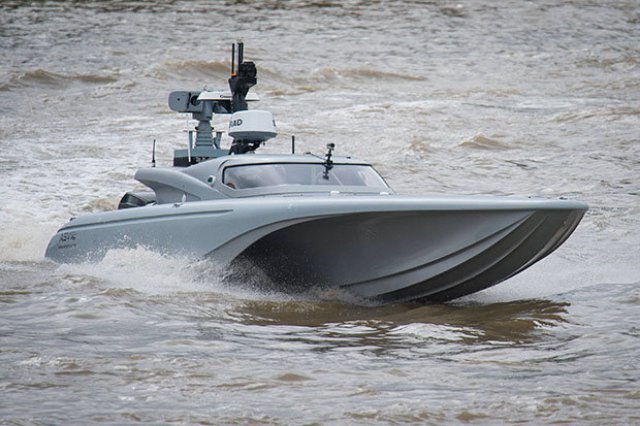 The UK Royal Navy has tested an unmanned speedboat on the River Thames ahead of a naval drone exercise off the UK coast this autumn. To the delight of tourists, Tower Bridge swung open to let through the sleek, low-slung craft, known as Mast (Maritime Autonomy Surface Testbed).
The UK Royal Navy has tested an unmanned speedboat on the River Thames ahead of a naval drone exercise off the UK coast this autumn. To the delight of tourists, Tower Bridge swung open to let through the sleek, low-slung craft, known as Mast (Maritime Autonomy Surface Testbed).
Accompanied by the patrol craft HMS Archer, the 32ft-long Mast spent an hour today, Monday, weaving between pleasure boats and goods barges at a moderate pace, heading up the river towards Westminster before returning downriver.
Although it is capable of navigating and avoiding collisions autonomously and can be operated via remote control, Mast had a coxswain on board to take control if needed because of Port of London bylaws, which also limited the speeds at which it could travel.
Mast is being developed with research funding from the Ministry of Defence’s science and technology laboratory, to explore how well such vessels function autonomously.
It is expected to eventually play a role in surveillance and reconnaissance.
The words “drone” and “unmanned” are usually associated with aircraft, but the world’s militaries have long been interested in their potential at sea.
“In some senses the maritime environment is playing catch-up when it comes to unmanned technologies but the potential is very significant,” said Nick Giles, a marine analyst at the International Institute for Strategic Studies, a military thinktank.
Unmanned fleets were viewed as transformational in tasks such as anti-submarine activity and surveillance, Giles said, but the technical challenges were also significant.
This autumn the Navy is hosting the Unmanned Warrior exercise, which takes place off west Wales, north-west Scotland and the Western Isles.
Mast and more than 40 other drone systems will take part in what the navy describes as the biggest effort to test such systems in an operational environment.
Unmanned Warrior is organised in collaboration with industry and allied forces, including the US Navy. The exercise aims to showcase new technologies.
Admiral Sir Philip Jones, first sea lord and chief of the naval staff, said: “The growing scale of Unmanned Warrior is a clear demonstration of the Royal Navy’s ambition to lead and win through technological innovation.
“Unmanned maritime systems will change how we operate, but they’re just the start.”
Peter Roberts, an analyst at the Royal United Services Institute, said the initiative lagged years behind similar efforts such as a project by the US Navy, named Thunderstorm.
The US invited manufacturers of unmanned technology to real-world operations against drug smugglers in the Caribbean.
“They wanted to get value for taxpayer money, so they made the technology companies do this somewhere there was a problem they could potentially solve, rather than testing them in a nice clean environment,” he said.
“They had to prove their equipment worked outside of clean conditions.”
The Royal Navy had “plenty of places to demonstrate it has real utility”, such as on Nato’s southern flank, Roberts said.
Instead, Unmanned Warrior was “late to the game and not very ambitious”, he said, and was functioning as a “sales pitch from the UK for business”.
The UK was one of the first countries to acquire armed aerial drone capability, but Roberts said the country lagged behind the US, China, Japan, Russia and even Vietnam when it came to naval robotics.
Source: Plymouth Herald
